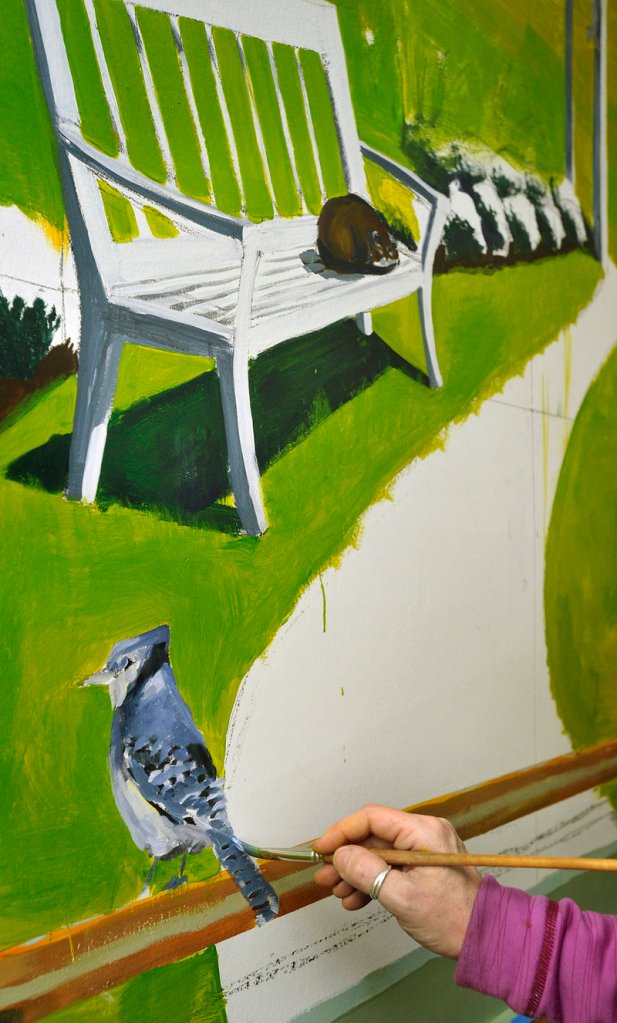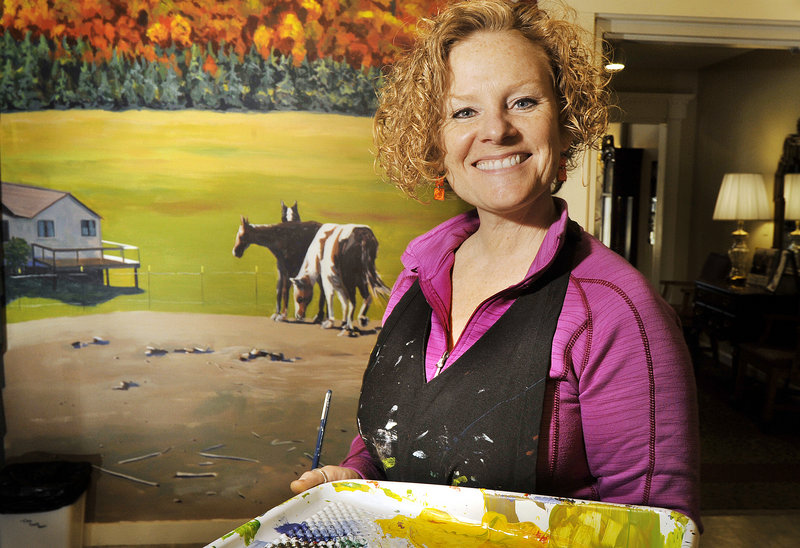AUBURN – Jacqueline Fortunato waves a steady hand toward the mural that Francine Schrock is painting, and proudly declares in her firm, 88-year-old voice, “Those turkeys, they were my idea!”
Fortunato, a resident at Schooner Estates Retirement Community, checks in daily with the progress that Schrock is making on a panoramic mural in the community room of the retirement center.
The wraparound mural depicts scenes from across Lewiston and surrounding hills and mountains. It includes the twin spires of the Basilica of Saints Peter and Paul, the long-closed mills of downtown, a pastoral autumn setting and, to the delight of Fortunato and her peers, a green spring field of frolicking turkeys.
“It makes you feel alive,” Fortunato says. “It makes you feel more like spring.”
Schrock, a Maine College of Art graduate who lives in South Portland, is best known for her realistic cityscapes and seascapes of Portland and the coast.
Lately, she has channeled the spirit and lineage of Maine’s great muralist Rufus Porter and taken on these large-scale interior wall paintings in retirement homes. It’s a way to connect with a population often neglected by the art world while also helping them rekindle memories and sharpen their minds.
The mural at Schooner Estates is the second Schrock has tackled. Her first was at Fallbrook Woods, a residential care home in Portland that specializes in Alzheimer’s disease and other memory impairments. Both Fallbrook Woods and Schooner Estates are owned by John Orestis and Barbra Crowley of Portland.
Schrock painted the Fallbrook Woods mural last fall, and moved on to Schooner Estates in January. She will do another mural in an independent-living wing at Schooner Estates when she finishes up her “Village Green” project in the retirement home’s community room.
It’s a place where residents come together every day for refreshments and socialization, said John Rice, director of operations at Schooner Estates.
“They sit here, and she paints things they recognize and that are meaningful to them,” he said. “They engage in the opportunity to create. They are just as much a part of the creative process as Francine is. It brings meaning to their lives.”
The residents are quick to offer feedback, Schrock said. And make no mistake, she added with a laugh, they are as tough as any of her art-school professors during the end-of-semester critiques.
“They know what’s right and they know what they want to see,” she said. “They’re very good at telling you what they like and what they don’t like, and what’s out of proportion and what I’ve screwed up.”
Aside from beautifying the property, the mural project has helped residents feel better physically and mentally, said Linda Olore, administrator at Fallbrook Woods. It’s a form of art therapy.
“A calmness comes over the residents when they are sitting out there,” she said. “They are able to articulate more words and speak more clearly while sitting in front of the mural. It is one of the most amazing things I have ever seen.”
Olore hatched the idea for the mural while talking to local musician Kate Schrock, who is not related to Francine. When not making a living as a musician, Kate paints home interiors. Olore hired her to do some painting, and asked if she’d be willing to try painting a mural.
Kate was interested and willing to try, but suggested her friend Francine would be better qualified.
Working together, the two Schrocks and Olore reached an agreement with Maine Paint Co. to supply Benjamin Moore latex paints. Meanwhile, Francine began meeting with residents to gather their ideas for the painting.
They shot down her initial suggestions of seascapes. Generally, water creates a sense of fear among people with Alzheimer’s, Olore said. Instead, they wanted warm and lush landscapes, with barnyards and lupines.
They suggested specific animals, scenes and settings, including tree species and other details.
For Schrock, who is accustomed to painting on relatively small canvases, the mural project required a massive jump in scale and vision.
It has given her a sense of appreciation of the work of Massachusetts-born Porter and other 19th-century painters who traveled the countryside creating pastoral scenes in the private homes of residents. Porter’s nephew, Jonathan D. Poor, painted many homes in Maine. Their murals are all over New England, especially in rural Maine.
The Porter story is interpreted at the Rufus Porter Museum in Bridgton.
Many of those early murals are now covered by wallpaper or multiple coats of paint. But many others have been conserved and preserved, and there is growing awareness of, and interest in, this kind of work.
Although she is new to the field, Schrock sees herself as a descendant of the muralists of the 1800s.
“It’s certainly a different kind of painting. I can’t obsess over details as I might with some of my other paintings,” she said. “But it’s a lot of fun, and it really allows you to use your imagination and think about your subject in a different way.”
The project has been rewarding, because Schrock knows she provides a meaningful experience for these elderly residents.
She has made many new friends, and feels she is the beneficiary of the project.
“Working with these wonderful people has been amazing,” she said. “This project has become very important to me, because it has allowed me to connect with them, to get to know them and become friends with them. They tell me stories about their lives, and they tell me what they want to see in the paintings. It’s an honor to work with them.”
Staff Writer Bob Keyes can be contacted at 791-6457 or:
bkeyes@pressherald.com
Twitter: pphbkeyes
Send questions/comments to the editors.





Success. Please wait for the page to reload. If the page does not reload within 5 seconds, please refresh the page.
Enter your email and password to access comments.
Hi, to comment on stories you must . This profile is in addition to your subscription and website login.
Already have a commenting profile? .
Invalid username/password.
Please check your email to confirm and complete your registration.
Only subscribers are eligible to post comments. Please subscribe or login first for digital access. Here’s why.
Use the form below to reset your password. When you've submitted your account email, we will send an email with a reset code.